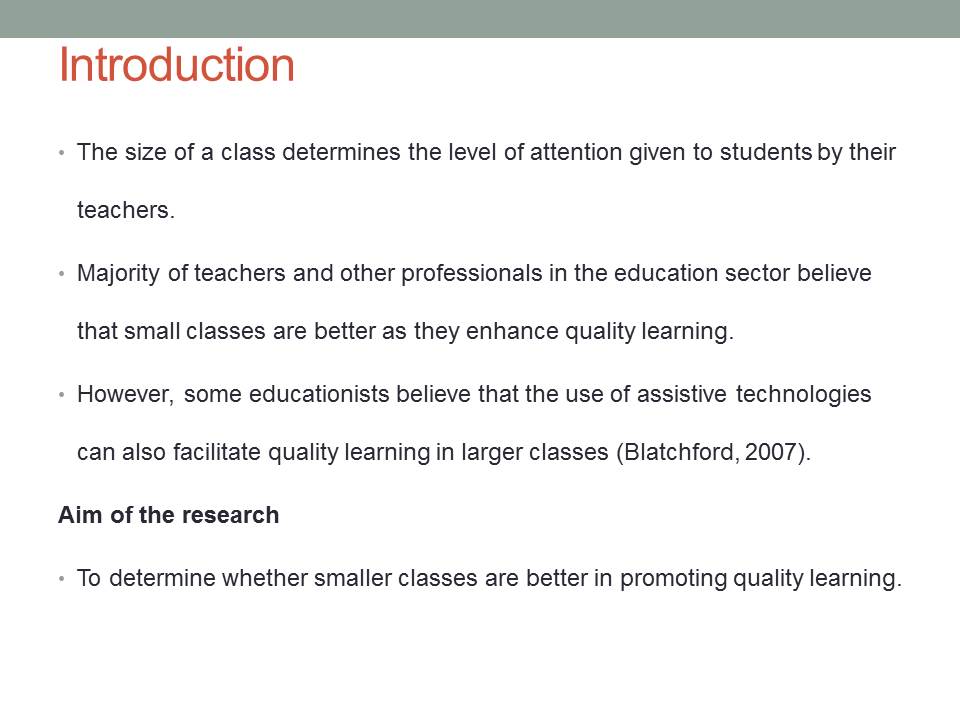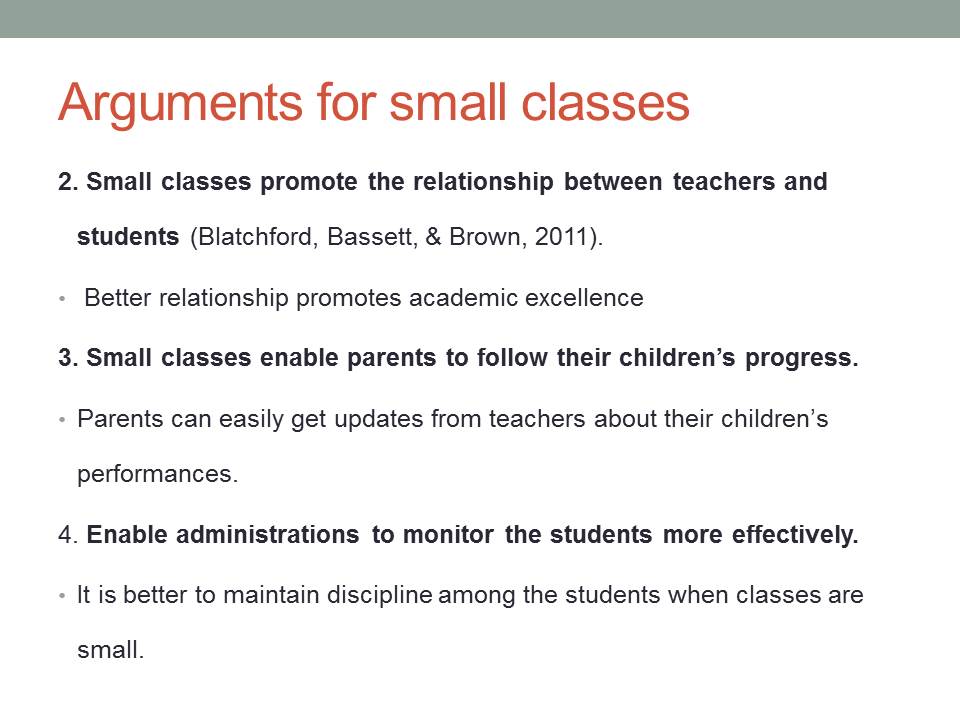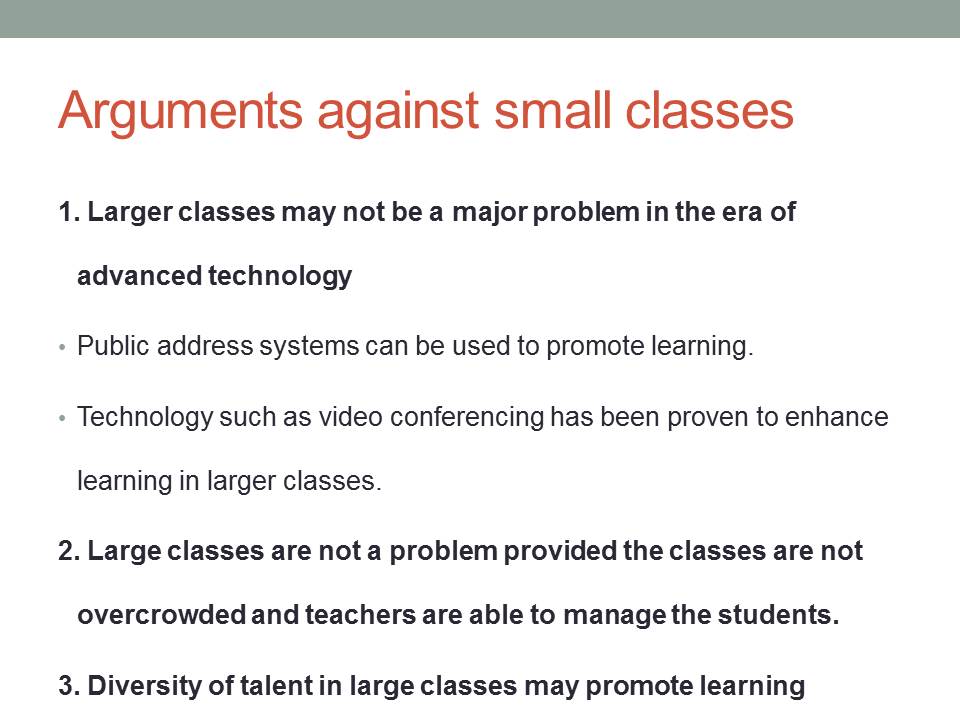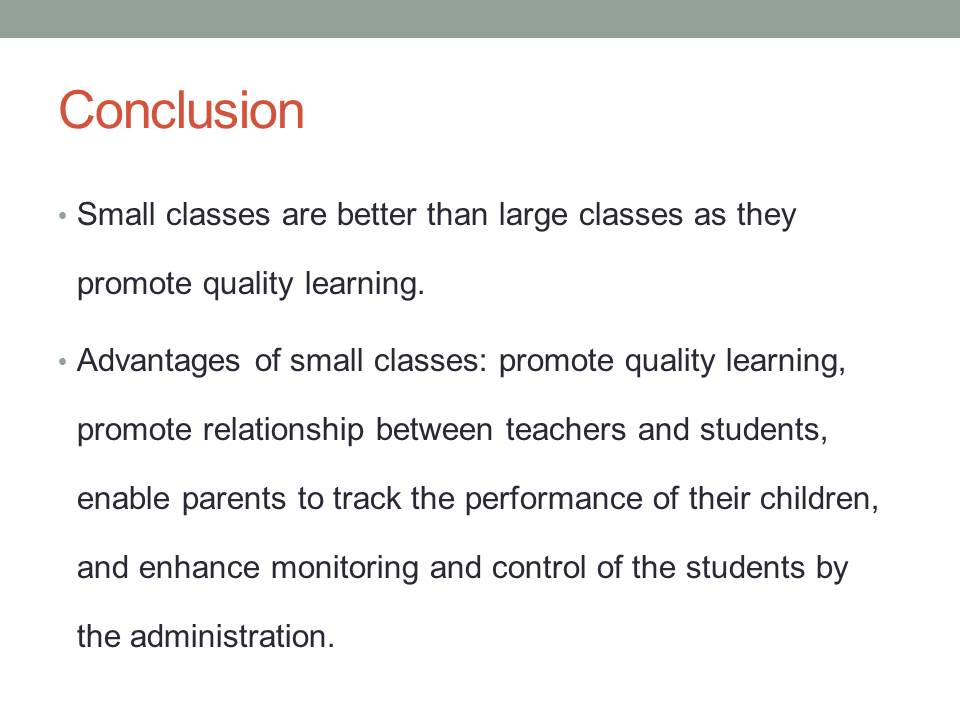Introduction
- The size of a class determines the level of attention given to students by their teachers.
- Majority of teachers and other professionals in the education sector believe that small classes are better as they enhance quality learning.
- However, some educationists believe that the use of assistive technologies can also facilitate quality learning in larger classes (Blatchford, 2007).
Aim of the research
- To determine whether smaller classes are better in promoting quality learning.
- Less attention is given to students in larger classes.
- More assistive technologies in classes have been developed to enhance learning among students.

Arguments for small classes
- Educationists and stakeholders argue that smaller classes are better because.
They promote the quality of education
- Students pay more attention to their teachers.
- Teachers are able to deal with specific problems affecting the students.
- Resources such as books, computers, and other learning materials are easily shared.
- Smaller classes are beneficial to all the stakeholders in education.
- Children receive more attention from the teachers.
- When dealing with larger classes, teachers become overwhelmed and hence unable to give personalized attention to their students.
- The students tend to seek more clarification on unclear issues when classes are small.
- Teachers are also able to identify any problems affecting the performance of their students.
- Resources are better shared when the classes are smaller. These resources may include books, computers, and other materials used to facilitate learning.
Small classes promote the relationship between teachers and students (Blatchford, Bassett, & Brown, 2011):
- Better relationship promotes academic excellence.
Small classes enable parents to follow their children’s progress:
- Parents can easily get updates from teachers about their children’s performances.
Enable administrations to monitor the students more effectively:
- It is better to maintain discipline among the students when classes are small.
Teacher-student relationship
- Smaller classes benefit teachers as they are able to monitor the progress of the students more effectively.
- Teachers are able to understand the strength and weaknesses of their students. In this view, they can work on improving the ability of the weaker students.
- Better and easier management of the students.
- Marking homework and exams becomes easier when dealing with a small number of students.
- Easier to divide resources among the students.
Enable parents to follow their children’s progress
- Smaller classes enable teachers to learn more about the student’s personalities.
- It is easier for parents to discuss with the teachers about their children’s performance.
- Reduces the duration of consultation between parents and teachers.
- On the contrary, teachers in large classes tend to have less information about their students.
- Some parents may be discouraged from following up with the teachers when the classes are large.
Enable administrations to monitor the students more effectively
- Easier to monitor the behavior of the students.
- Easier to instill or restore discipline among the students.
- The administration may lack proper control of the students if the classes are large.
- Administrators are able to detect problems affecting the students on time if classes are smaller.
- Ensure that such problems are dealt with early enough.
- Planning becomes easier when dealing with a small population of students.
- It is easier to follow up with the parents in case a student has a problem.


Arguments against small classes
Larger classes may not be a major problem in the era of advanced technology:
- Public address systems can be used to promote learning.
- Technology such as video conferencing has been proven to enhance learning in larger classes.
Large classes are not a problem provided the classes are not overcrowded and teachers are able to manage the students.
Diversity of talent in large classes may promote learning.
Arguments against smaller classes
- Teachers are able to teach students from different regions in the world through video conferencing.
- Public address systems enhance understanding of information delivered by teachers. Additionally, learners are able to ask questions and clarify on issues that are not well understood.

Position of the researcher
- Majority of the research analyzed supports small classes as they promote quality learning.
- The researcher supports the argument for smaller classes as they enhance quality learning.
- Parents and teachers are able to monitor the performance of the students more effectively.
- Scrambling for resources hinders quality learning.
- Crowded classes hinder the provision of quality learning environment for the students.

Conclusion
- Small classes are better than large classes as they promote quality learning.
- Advantages of small classes: promote quality learning, promote relationship between teachers and students, enable parents to track the performance of their children, and enhance monitoring and control of the students by the administration.
- Even though some researchers have in the past argued in support of larger classes, the advantages of smaller classes seem to outweigh those of larger classes.

References
Blatchford, P. (2007). The Class Size Debate. Maidenhead: McGraw-Hill International Ltd.
Blatchford, P., Bassett, P., & Brown, P. (2011). Examining the effect of class size on classroom engagement and teacher pupil interaction: Differences in relation to pupil prior attainment and primary vs. secondary schools. Learning and Instruction, 21(7), 715-730.